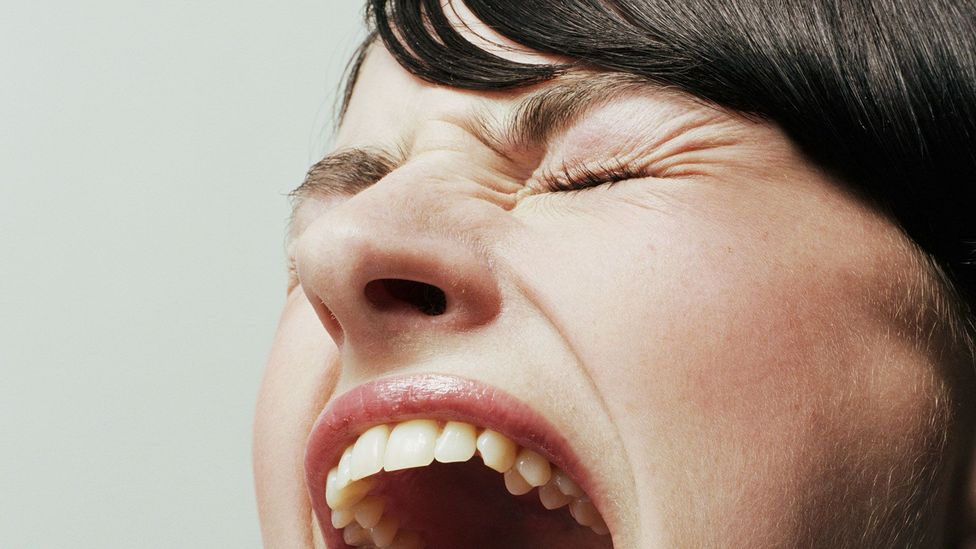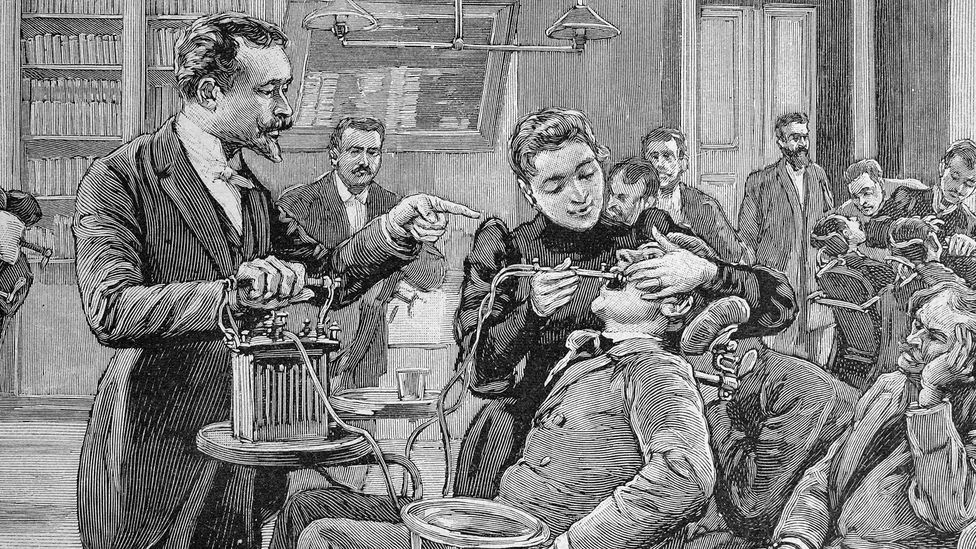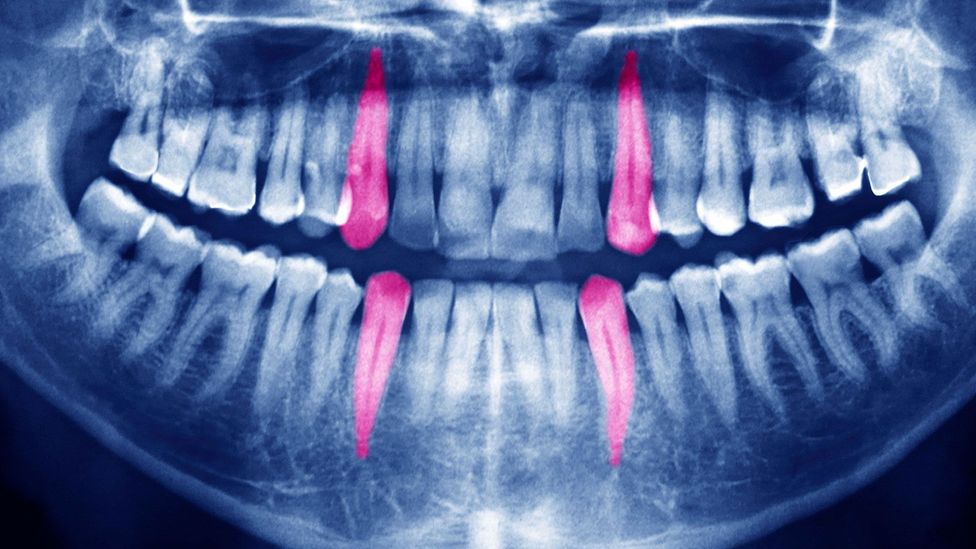Iola The Explosion The Day Went Cold Again
The gruesome and mysterious case of exploding teeth
(Image credit:
Getty Images
)

Following months of agonising toothache, 19th Century patients sometimes found their teeth shattering in their mouths – with a force that nigh knocked one woman over.
I
In the 19th Century, a Pennsylvania dentist called WH Atkinson came across a condition that sounds similar the stuff of nightmares. Writing in The Dental Cosmos, the outset major journal for American dentists, Atkinson documented an outbreak of exploding teeth.
He saw it in three patients. The first, the Reverend DA from Springfield, went through this unpleasant ordeal in 1817:
The correct superior canine or first bicuspid commenced aching, increasing in intensity to such a degree as to set him wild. During his agonies he ran most here and there, in the vain endeavour to obtain some respite; at one time ho-hum his caput on the ground like an enraged animal, at another poking it nether the corner of the contend, and over again going to the bound and plunging his head to the bottom in the cold h2o.
Not terribly dignified behaviour for a clergyman, which gives you some idea of how much pain he must have been in. Toothache could be sheer torture in the era before cheap and effective dentistry: an inquest in Sussex in 1862 heard how a man took his own life afterward a toothache lasting 5 months, "during which time he was observed to cry, twenty-four hours by day, for hours together". The unfortunate priest had a happier issue:
All proved unavailing, till, at 9:00 the next forenoon, as he was walking the flooring in wild delirium, all at one time a sharp fissure, like a pistol shot, bursting his tooth to fragments, gave him instant relief. At this moment he turned to his married woman, and said, "My pain is all gone." He went to bed, and slept soundly all that day and most of the succeeding night; subsequently which he was rational and well.

Did the metals in early fillings react to release a build-up of hydrogen that exploded in the patients' mouths? (Credit: Alamy)
Xiii years afterwards this distressing incident, something similar happened to a patient known as a Mrs Letitia D, who lived only a few miles away. She suffered a prolonged toothache, "terminating by bursting with report, giving firsthand relief".
The final instance in this trio of dental disasters occurred in 1855. Mrs Anna PA reported that one of her canines split from front to back:
A sudden, sharp report, and instant relief, as in the other cases, occurred in the left superior canine. She is living and healthy, the mother of a family of fine girls.
Although unusual, these stories are not unique. The editors at the British Dental Periodical recently highlighted a lively correspondence from its archives, originally printed in 1965, detailing many other tales of detonating dentine throughout history.
They included a case recorded in 1871 past another American dentist, J Phelps Hibler. He treated a young woman whose toothache ended spectacularly when the molar, a molar, "bursted with a concussion and report, that well-almost knocked her over". The explosion was and so loud that she was deafened for some days afterwards.
Although there were five or half-dozen reported cases in the 19th Century, there has been no documented example of exploding teeth since the 1920s. Hugh Devlin, Professor in Restorative Dentistry at the Academy of Manchester'southward School of Dentistry, says that although it is fairly common for diseased teeth to separate, he'south never heard of one going bang. He recalls that Antarctic explorers in the 1960s reported their teeth shattering spontaneously, thought at the time to have been the result of extreme cold – but he believes the existent culprit was caries (tooth decay) caused by their high-carbohydrate nutrition.
So what caused these dramatic dental explosions? In his 1860 article Atkinson offered two culling explanations. The first was that a substance which he called 'free caloric' was building up in the tooth and causing a dramatic increase of pressure in the lurid. This hypothesis tin be ruled out directly away, since it relies on an obsolete scientific theory. For many years, estrus was believed to consist of a fluid chosen 'caloric', which was self-repelling – although this would make a force per unit area increase plausible, we now know that no such fluid exists.

Without understanding the cause of the exploding teeth, we cannot be sure that it will not afflict another patient in the future (Credit: Alamy)
At first glance, Atkinson's 2nd idea seems more than apparent. He suggested that decay within the molar might have caused a build-up of gas, which eventually fabricated the molar fracture.
Could this explain the mystery? Devlin is sceptical: "It is highly unlikely that gas could build up in a tooth sufficient to cause information technology to explode – teeth are extremely strong. The 19th Century dentists didn't empathise caries – they thought it came from within the tooth. Information technology's only in the concluding century that we started understanding that caries is acquired by diet and past bacteria building upward on the surface of the teeth."
Instead, the answer may lie in the chemicals used to make early fillings. Before the advent of mercury constructing in the 1830s a wide variety of metals were used to fill up dental cavities, including atomic number 82, tin can, silverish and various alloys. Andrea Sella, Professor of Inorganic Chemistry at Academy College London, points out that if ii different metals had been used this would create an electrochemical cell – effectively, the whole mouth would be turned into a depression-voltage battery: "Considering of the mixture of metals you have in the mouth, there might be spontaneous electrolysis. My favoured explanation is that if a filling were badly done so that office of the crenel remained, that would hateful the possibility of build-up of hydrogen inside a molar."
An already weakened tooth might conceivably burst under this pressure – and the hydrogen could even explode if ignited, for instance if the patient were smoking at the time or if an atomic number 26 filling caused a spark in the mouth. Sella concedes that this scenario is a little far-fetched: "My feeling is that at that place wouldn't be a jet of flame coming from this Victorian admirer's rima oris."
Unfortunately, at that place'southward no evidence that whatsoever of the original patients actually had fillings. So either an unknown process was causing the explosions or the patients were exaggerating symptoms which were far more mundane. For at present at least it seems that the "mystery of the exploding teeth" will remain unsolved.
---
This commodity was based on a post on Thomas Morris'southward weblog on the history of medicine, which tin can be institute at www.thomas-morris.uk . He tweets at @thomasngmorris .
Join 500,000+ Future fans past liking united states on Facebook , or follow us on Twitter , Google+ , LinkedIn and Instagram .
If yous liked this story, sign up for the weekly bbc.com features newsletter , called "If You lot Only Read 6 Things This Week". A handpicked selection of stories from BBC Future, Earth, Culture, Capital letter, Travel and Autos, delivered to your inbox every Fri.
trosclairamurectime.blogspot.com
Source: https://www.bbc.com/future/article/20160301-the-gruesome-and-mysterious-case-of-exploding-teeth
0 Response to "Iola The Explosion The Day Went Cold Again"
Publicar un comentario